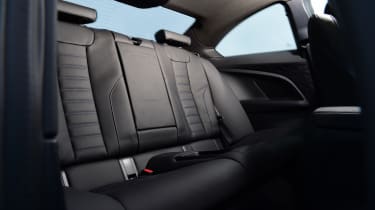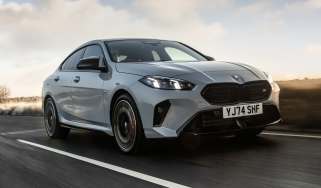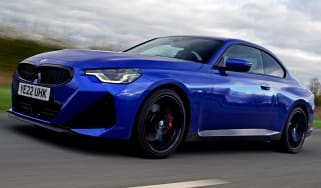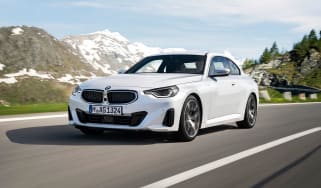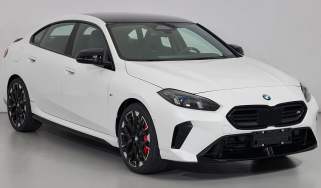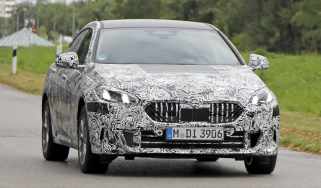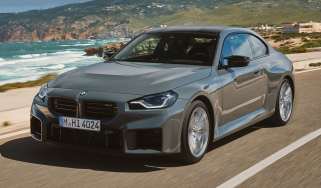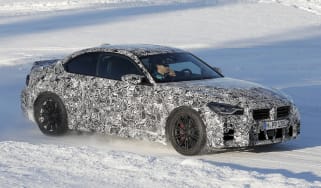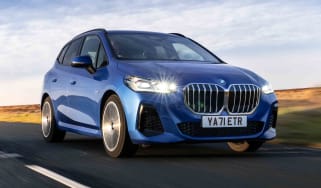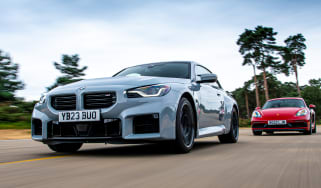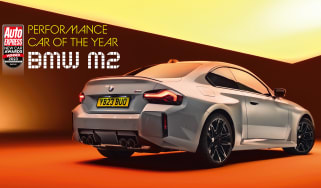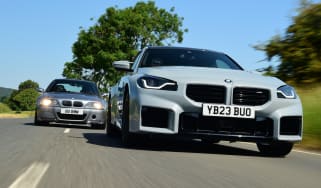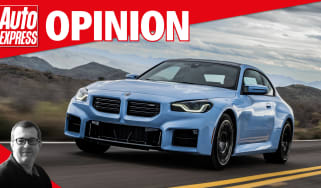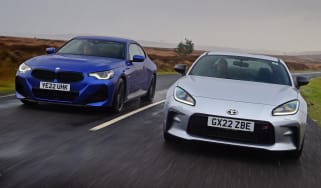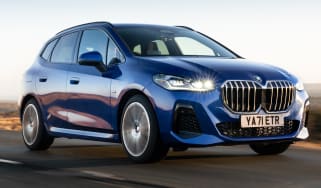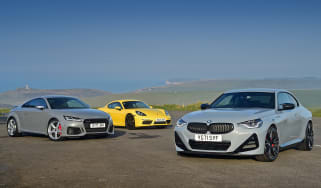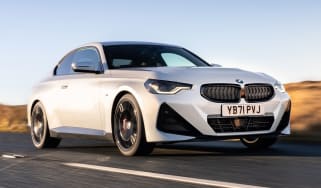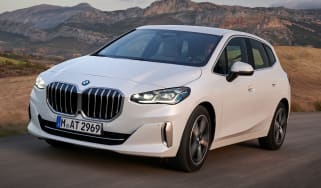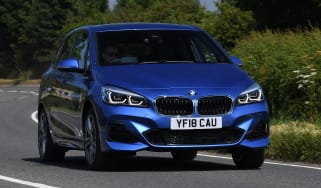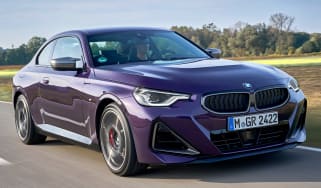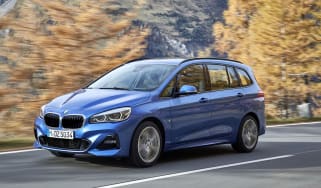BMW 2 Series Coupe review
Fun to drive, with a great mix of performance and usability, the BMW 2 Series Coupe is a strong all-rounder

BMW has got it pretty much spot on with its second-generation 2 Series Coupe. Keen drivers will be particularly impressed by the dynamic talents of the M240i performance model, but it’s as an overall package that the small coupe really stands out from its rivals.
The 2 Series Coupe offers plenty of driving fun, along with a surprising level of practicality, while its muscular styling gives it a real presence on the road. Entry-level petrol and diesel engines may not offer quite enough performance for some buyers, but that’s being picky as all models offer the same fantastic driving DNA. The BMW 2 Series was named as our Coupe of the Year in 2025.
About the BMW 2 Series Coupe
Small combustion-engined coupes are becoming an increasing rarity in showrooms across the UK. With customer demand slowing and manufacturers turning their attention towards an electrified future, models such as BMW’s 2 Series Coupe are swimming in an ever-decreasing pool of rivals.
Despite the competition dwindling in number, those models left battling it out for small coupe supremacy are mostly premium challengers that offer bags of style and excellent driving dynamics. The Porsche 718 Cayman is a driving enthusiast’s dream, while the Alpine A110 is a more left-field choice, but both will give buyers considering a high-spec 2 Series Coupe model much to ponder.
Used - available now

2026 BMW
2 Series
40,093 milesAutomaticPetrol2.0L
Cash £26,000
2020 BMW
2 Series
27,880 milesManualPetrol1.5L
Cash £15,195
2026 BMW
2 Series
12,500 milesAutomaticPetrol2.0L
Cash £29,700
2020 BMW
2 Series
72,388 milesManualDiesel2.0L
Cash £11,497The Toyota GR86, is a more affordable sports car proposition that delivers some of the purest driving thrills of any car you can buy today but is no longer on sale. Toyota’s more powerful GR Supra is another option, while the stylish Audi TT is hard to overlook, particularly in performance S or RS form, however it’s going to be discontinued very soon. For those seeking a little more space there’s even the Ford Mustang to consider, with the added appeal of its V8 soundtrack.
While the rest of the 2 Series family – the four-door Gran Coupe and Active Tourer MPV – rely on front-wheel drive, the Coupe stands out as the driver’s choice by retaining its rear-wheel drive layout. If you were hoping to put your left foot to good use and get a 2 Series Coupe with a manual transmission, the only transmission available is an eight-speed ‘Sport Automatic’ as BMW calls it.
Engine choices for the 2 Series Coupe are limited to a 2.0-litre, four-cylinder petrol unit available with either 181bhp (220i) or 242bhp (230i). The 187bhp 2.0-litre diesel (220d) powerplant has now been removed from the price list.
The standalone M240i model utilises BMW’s xDrive all-wheel drive system to help distribute the 369bhp generated by its brawny 3.0-litre, six-cylinder petrol engine. If that’s not potent enough for you, one of BMW M division's more hardcore sports cars, the new M2, pumps out 453bhp and 500Nm of torque for rapid pace – just one of the reasons why it won our 2023 Performance Car of the Year award.
Most buyers of BMW coupe models are drawn to the ever-popular M Sport trim, with its bigger alloy wheels and stylish bodykit giving a taste of a bona-fide M model at a much smaller cost. The German manufacturer clearly thinks this is the way forward as M Sport is the only specification available for the second-generation 2 Series Coupe, with no SE or Sport trims on the price list.
It’s worth noting that while the 2 Series Coupe hasn’t received a full facelift, the infotainment setup has been upgraded. Models produced from July 2022 onwards feature BMW’s latest iDrive 8 infotainment, plus a 12.3-inch instrument panel and 14.9-inch central touchscreen. Android Auto and wireless Apple CarPlay are both standard-fit, too.
Engines, performance and drive
Although its Gran Coupe and Active Tourer siblings are based on the front-wheel drive UKL platform, the 2 Series Coupe uses BMW’s CLAR underpinnings which means it can offer rear or all-wheel drive set-ups. The German manufacturer claims its Cluster Architecture helps to improve the Coupe’s agility, while bringing more accurate steering and enhanced cornering dynamics. Torsional rigidity is also up by 12 per cent over the previous model.
BMW expects the entry 181bhp 220i petrol model to be its biggest seller. Aside from the fact it’s around £4,000 cheaper than its more powerful 230i sibling, it has just enough oomph to keep things interesting, although the way it delivers its power is rather benign.
There’s no massive turbo surge in the mid-range, and there’s no point wringing it out to the red line – it’s better to view the 220i as a swift(ish) coupe that’s more at home as a refined cruiser than a rev-happy racer. If you’re prioritising a little more B-road ability, then the 230i petrol version offers the extra power (61bhp) and torque (100Nm) to help keep things entertaining.
With a focus on achieving a 50:50 weight distribution, BMW has engineered the 2 Series Coupe with its bonnet, front wings and suspension components all made of lightweight aluminium – helping to reduce weight from the nose and making the car keener to turn-in. It all feels sharp, but easily controllable, although we’d like a little more steering feel when on the limit.
The M240i model utilises BMW’s xDrive all-wheel drive system, but retains a rear-drive feel and balance to how it handles. We like it a lot, and value its ‘mini-GT’ character over rivals such as the Porsche Cayman and Audi TT. The more hardcore M2 is rear-wheel drive-only, thrilling to drive, incredibly quick and full of character, yet its smooth ride and modest dimensions make it a performance car you can drive every single day.
0-62mph acceleration and top speed
You might find the 2 Series engine range slightly limited, but there should be just enough on offer for most tastes. First up is the 220i 2.0-litre petrol model, and with 181bhp and 300Nm of torque it manages 0-62mph in a passable 7.5 seconds and a top speed of 147mph. The axed 220d diesel version provided 187bhp and 400Nm of torque which helped it cut the 0-62mph sprint time to 6.9 seconds, but top speed was the same.
Things start to get a little more serious with the 230i petrol model; it generates 242bhp and has the same torque figure as the diesel unit, although it manages to trim a full second from the oil burner’s 0-62mph time. The 230i feels much stronger than the lesser 220i, and its extra shove can be felt throughout the rev range. The four-pot engine doesn’t produce the most soulful exhaust noise, but it’s got a deep, bassy tone.
The numbers for the standalone M240i xDrive speak for themselves: with 369bhp and 500Nm of torque on tap from its 3.0-litre, twin-turbocharged six-cylinder petrol engine, it blasts from 0-62mph in 4.3 seconds and can hit a top speed of 155mph. The rich six-cylinder soundtrack adds to the driving experience, and it even sounds special when you’re pottering around at low speeds.
The M2 turns things up to 11, with the twin-turbo, 3.0-litre straight-six under its bulging bonnet producing a hefty 454bhp and 550Nm, all of which is sent to the rear wheels only. Equipped with the standard automatic the M2 will hit 62mph in 4.1 seconds, while those featuring the optional six-speed manual take 4.3 seconds to complete the same benchmark sprint. Top speed stands at 155mph.
MPG, CO2 and running costs
The 2 Series Coupe isn’t offered with fuel-saving hybrid technology, or as an EV, but the beauty of sporty coupe is that, along with being great fun to drive, they’re relatively lightweight and aerodynamic which helps to keep fuel economy pretty reasonable.
The most efficient option originally was the 220d 2.0-litre diesel engine, which BMW said could return up to 60.1mpg, and CO2 emissions of 122g/km meant it was pretty appealing to company car drivers who like to take the scenic route to work.
Unfortunately for them, the 2 Series Coupe is now available exclusively with petrol power. According to BMW, the entry-level 220i and its 2.0-litre four-pot engine will return up to 44.1mpg, while emitting between 144-149g/km of CO2.
The more powerful 230i is slightly less economical on paper, and will achieve 42.8mpg at best – presumably if you break out the heavy foot on rare occasions. However, during our group test between the 230i and the Toyota GR86, we managed to see 32.5mpg from the BMW compared to the Toyota’s 31.3mpg. Driven with proper enthusiasm, both cars would easily dip into 20mpg territory.
With its 3.0-litre, twin-turbo six-cylinder engine adding a whole lot more power, and the xDrive all-wheel-drive system adding a little extra weight too, the M240i performance model emits 185-200g/km of CO2 and returns a claimed maximum of 34.4mpg. Although when we pitched it up against the Audi TT RS and the Porsche Cayman in our own three-way test, the M240i averaged 27.4mpg, the TT RS managed 28.1mpg, while the less potent Cayman (with 296bhp) achieved 33.2mpg – all decent figures when you consider the near-supercar pace on offer.
Finally there’s the full-fat BMW M2, also powered by a twin-turbo six-cylinder, which BMW says can return between 28-29mpg depending on your choice of manual or automatic transmission. We covered plenty of miles when we tested the M2, including a stretch of motorway driving, yet it impressed us by returning 30.2mpg.
Insurance
As you might expect, the 454bhp M2 is the most expensive model to insure in the 2 Series Coupe lineup, sitting in insurance group 42 (out of 50). The 369bhp M230i is a close second in group 37, while the 230i version lands in group 33. The entry-level 220i petrol and now-discontinued 220d diesel are in groups 28 and 29, respectively.
In comparison, an entry-level Porsche Cayman sits in group 42, while the cheapest Audi TT model is in insurance group 36.
Check any car's MoT history in a few easy clicks with our MoT checker tool...
Depreciation
The BMW 2 Series Coupe should be a strong performer on the used market. Our expert data suggests that it should hold onto an average of 55 per cent of its original value after three years and 36,000 miles of motoring, with the M2 expected to perform the best.
To get an accurate valuation on a specific model check out our free car valuation tool...
Interior, design and technology
The second-generation 2 Series Coupe certainly looks like a car that makes you want to get behind the wheel and go for a drive. An increase in overall width, coupled with a lower roof line help to give it a muscular, purposeful stance, while BMW has worked in the odd nostalgic touch; the circular headlight unit design is claimed to be inspired by the 2002 from the 60s and 70s, while the rear box arches are influenced by the strong, stylish lines of the original M3.
Interior quality is very good, with the 2 Series showcasing a similar cabin to the bigger 4 Series Coupe. With just the M Sport trim available, standard kit is reasonable and includes 18-inch alloys (though 19-inch rims are a no-cost option), front and rear parking sensors, heated front sports seats, climate control, a 12.3-inch digital driver’s display and a 14.9-inch infotainment screen running BMW’s latest iDrive 8 infotainment system.
That means the only way to get any more kit is through the options list. Some elements are available as individual extras, like a towbar, electric sunroof, Harman Kardon sound system and heated steering wheel. Many more are bundled together in options packs. For instance, the Technology Pack includes a reversing camera and Parking Assistant system, a head-up display and wireless smartphone charging. Other packages available include Technology Plus Pack, Comfort Pack and M Sport Pro Pack.
Sat-nav, stereo and infotainment
At launch the 2 Series Coupe featured BMW’s iDrive 7 infotainment system (pictured above), but all models produced from July 2022 onwards are equipped with the very latest iDrive 8 setup. That includes a 12.3-inch digital driver’s display and huge 14.9-inch central touchscreen housed within a subtly curved panel, which in our opinion looks a lot more impressive than the two separate screens in earlier models like ours.
We’re very familiar with the iDrive 8 setup as it’s the same one you’ll find in the BMW iX, i4, X1/iX1, the facelifted 3 Series and even the 2 Series Active Tourer. However, we haven’t had a chance to see how it fits the 2 Series Coupe’s cabin or driver-focused personality. The 2 Series Coupe does keep the iDrive click-wheel and supplementary buttons at least, which means that it’s still possible to make minor adjustments and navigate menus on the move without much difficulty. Both Apple CarPlay and Android Auto remain standard-fit, too.
Practicality, comfort and boot space
If you’re after a two-door coupe, but still need to retain a little extra practicality, then the BMW 2 Series Coupe will certainly be of interest. Usable rear seats and a decent boot are handy features, while the composed ride, excellent build quality and strong engines ensure that time spent behind the wheel of BMW’s smallest coupe will be a comfortable experience.
The cabin is ergonomically sound, with a driver-focused dash that is slightly angled towards the right. Twin cupholders and a front armrest are well placed for ease of use, while BMW offers its optional Comfort Pack for around £1,300, which includes extras such as keyless entry, an automatic tailgate, electrically-adjustable front seats with a memory function and a heated steering wheel.
Dimensions and size
The second-generation 2 Series Coupe has grown compared to its predecessor; it’s 4,548mm long, 1,404mm tall and 1,838mm wide, meaning the new model is a full 105mm longer and 68mm wider, while the roof line is 28mm lower. It has a brawnier look which helps it stand out against rivals such as the stylish Audi TT and sporty Porsche 718 Cayman.
Leg room, head room and passenger space
Space upfront for the driver and passenger is fine, and if those in the front are less than six feet tall then even adults can fit in the back of the 2 Series Coupe, so long as they’re not too tall either. Headroom in the back is fairly tight mind you, but if you just need to run some friends into town, the rear seats work just fine and they’re comfortable and supportive, too.
The 2 Series Coupe even gets a set of ISOFIX mounting points in the rear, so it’s possible to install a child seat, though you’ve got to do that through the gap between the door opening and front seat.
Boot space
With a 390-litre boot, the 2 Series Coupe’s loadspace is a touch bigger than you’ll find in a Volkswagen Golf, although the 2 Series has a saloon-style bootlid rather than a more convenient hatchback opening. The rear seats do fold in a 40:20:40 split, which means you can carry larger items if needed, while loading should be easier as the boot lip is 35mm lower compared to the previous model.
Towing
All 2 Series Coupe models have a braked towing weight quoted at 1,600kg, while BMW will ask you for around £800 to fit a towbar.
Reliability and safety
The 2 Series Coupe is one of just three cars in BMW’s current lineup to not receive the maximum five-star crash safety rating from industry experts Euro NCAP. Instead, the 2 Series Coupe was awarded a four-star rating.
Its scores of 82 and 81 per cent for adult occupant safety and child passenger protection respectively were good, however the two-door coupe only received a 67 per cent in the Vulnerable Road Users category. Although the 2 Series’ active bonnet safety system worked ‘robustly’ in helping to reduce injuries to pedestrians in the event of a collision, Euro NCAP’s assessment was that ‘protection of the pelvis area was entirely poor.’
Unfortunately we can’t compare the 2 Series Coupe NCAP rating with the majority of its rivals, as neither the Alpine A110, Toyota GR86 nor Porsche 718 Cayman have been put through the organisation’s battery of crash tests. The only one that has is the Audi TT, but it was tested back in 2015 and its four-star rating has now expired. And because the organisation's assessment standards have become more stringent since then, it’s unlikely the TT would receive the same scores today.
The 2 Series Coupe didn’t make it onto our list of the best cars to own, which is based on owners’ feedback from the most recent Driver Power owner satisfaction survey. BMW was well represented in the list of the top-75 cars to own, with the 1 Series, 3 Series, 5 Series and i3 all making an appearance. BMW itself will be less pleased with its position in our best car manufacturer rankings, as it fell from 16th place in 2022 to 21st, though it did still finish ahead of key rivals Audi and Mercedes, and Volkswagen, too.
Warranty
The 2 Series Coupe is covered by a three-year/unlimited mileage warranty, while BMW offers various options to extend the cover at extra cost.
Servicing
Pay monthly servicing plans are available to help spread the cost of scheduled maintenance. Once you’re signed up, the servicing cost remains fixed for the duration of the plan.

